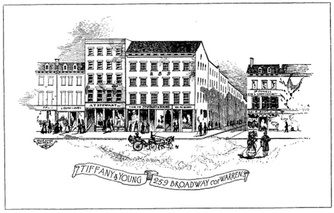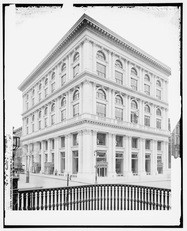
Advantage - DIAMONDS
Charles L. Tiffany along with his partner John B. Young, established a fancy-goods (small decorative gifts) and stationary store in 1837 as “Tiffany and Young.” In 1841, another partner, J. Lewis Ellis, was admitted into the firm which then became “Tiffany, Young & Ellis.” By this time the company was growing exponentially. The company was so in tune with its customers that in the four short years of its existence it had not only steadily grown, but had relocated several times to keep up with the growth. Soon Tiffany, Young & Ellis began sending a representative annually to Europe to secure the choicest creations. By 1848 they were creating their own silverware and diamond jewelry. However, in that same year the business met with some difficulties. Due to political disturbances in Paris, the price of diamonds plummeted to about fifty-percent of their then value. Rather than allow this to bring them down, the company took advantage of the situation and invested all available funds into diamonds, bringing the company to rank top among diamond merchants of the time.
Advantage - HISTORIC GEMS
With the success of their diamond purchase, the company plunged deeper into the precious stones market by purchasing notable gems — becoming one of the largest purchasers in the world. They obtained amazing pieces including those worn by Marie Antoinette and Hungarian Prince Esterhazy. Their greatest purchase in the nineteenth century was in 1887 when they obtained over one-third of the French crown jewels. This was a larger purchase than the nine next largest buyers combined.
Advantage - INTERNATIONAL BRANCHES
In 1850 the firm took on Gideon F. T. Reed from one of the leading jewelry houses in Boston, Massachusetts. It was immediately after this that the company established its first house overseas at 79 Rue Richelieu in Paris, France. This overseas branch was called Tiffany, Reed & Co. and became invaluable as Reed — being a resident partner — was able to take advantage of the fluctuations in the foreign market and develop a large profitable trade in Paris.
Advantage - SILVER
One year later, the highest quality silversmith of the time was contracted by Tiffany, Young & Ellis as an exclusive smithy for the company. Edward C. Moore brought a new artistry to the company’s silver products that was, as Henry Hall in his book, America’s Successful Men of Affairs: The City of New York, wrote: “marked by an individuality and strength of character wholly different from that of any other manufacturer.” It was at this point that the company began making special presentation pieces.

Tiffany and his partner John B. Young started out in New York City in a building “within their means.” Purchased with a thousand dollars loaned to them by Tiffany’s father, the building was, in Tiffany’s words, “an old fashioned double dwelling house at 259 Broadway.” Through the years, as success shined on the company, Tiffany contracted McKim, Mead & White — one of the best known architectural firms at the beginning of the twentieth century — to design a building on Fifth Avenue for Tiffany & Co. This would be the first large store to move north of 34th Street. The architectural firm would take their inspiration from a sixteenth century Venetian palace and adapt it to construct a seven floor building that The Minneapolis Journal would dub a “palace.” The building materials included marble, iron and terracotta with bronze metal work throughout. Paving the way for high-end businesses, the Tiffany & Co. Building would be heralded by the media as a commercial structure which reaches “the highest mark of artistic excellence.”
 401 Fifth Avenue
401 Fifth Avenue Contact us to learn more about the history of Charles L. Tiffany and the buildings the company occupied.
 RSS Feed
RSS Feed